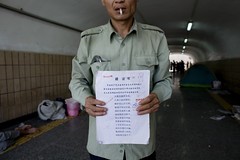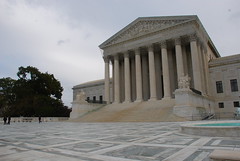 Image via WikipediaBy Rey Cartojano
Image via WikipediaBy Rey CartojanoFor a predominantly Catholic country as the Philippines, the refiling by the Gabriela women's party-list group of a controversial bill to legalize divorce in the country drew mixed reactions.
The refiled measure, now renamed House Bill No. 1799 (An Act Introducing Divorce in the Philippines), lists down five grounds for the filing of a petition for divorce:
1. Petitioner has been separated de facto (in fact) from his or her spouse for at least five years at the time of the filing of the petition and reconciliation is highly improbable;
2. Petitioner has been legally separated from his or her spouse for at least two years at the time of the filing of the petition and reconciliation is highly improbable;
3. When the spouses suffer from irreconcilable differences that have caused the irreparable breakdown of the marriage;
4. When one or both spouses are psychologically incapacitated to comply with the essential marital obligations;
5. Any of the grounds for legal separation that has caused the irreparable breakdown of the marriage.
Under the present law, particularly Article 36 of the Family Code of the Philippines, only psychological incapacity is the only ground for annulment of marriage, and the process of securing annulment is not only tedious but expensive as well, making the provision biased in favor of those who have the financial means to sustain costly litigation.
Under the proposed divorce bill, separation in fact (de facto) for five (5) years and legal separation for two (2) years are already grounds for divorce, as long as reconciliation of the spouses is highly improbable. Separation in fact is a widespread phenomenon in the Philippines, especially for couples who could not afford the legal process of annulment, thus providing these separated couples a ground to formally and legally severe their marital ties. On the other hand, legal separation for two (2) years is thought by the proponents of the divorce bill enough basis to proceed to divorce, considering that the spouses already passed the ordeal and process of legal separation.
The third ground is irreconcilable differences that caused irreparable breakdown of marriage. What these irreconcilable differences are not clear, for as long as they caused irreparable breakdown of marriage, again without sufficiently defining what irreparable breakdown of marriage means. The third ground provides possible judicial interpretation based on the facts of the case, which can be questioned as unwarranted delegation of legislative authority, i.e., judicial legislation, or simply unconstitutional for being vague.
The fourth ground of psychological incapacity is feared to be a useless provision if the proposed divorce bill is passed into law, as the other grounds will be easier to establish and less costly for the parties. In fact, the existence of the third ground of irreconcilable differences, which is broader in scope, will be sufficient to absorb this ground of psychological incapacity.
1. Petitioner has been separated de facto (in fact) from his or her spouse for at least five years at the time of the filing of the petition and reconciliation is highly improbable;
2. Petitioner has been legally separated from his or her spouse for at least two years at the time of the filing of the petition and reconciliation is highly improbable;
3. When the spouses suffer from irreconcilable differences that have caused the irreparable breakdown of the marriage;
4. When one or both spouses are psychologically incapacitated to comply with the essential marital obligations;
5. Any of the grounds for legal separation that has caused the irreparable breakdown of the marriage.
Under the present law, particularly Article 36 of the Family Code of the Philippines, only psychological incapacity is the only ground for annulment of marriage, and the process of securing annulment is not only tedious but expensive as well, making the provision biased in favor of those who have the financial means to sustain costly litigation.
Under the proposed divorce bill, separation in fact (de facto) for five (5) years and legal separation for two (2) years are already grounds for divorce, as long as reconciliation of the spouses is highly improbable. Separation in fact is a widespread phenomenon in the Philippines, especially for couples who could not afford the legal process of annulment, thus providing these separated couples a ground to formally and legally severe their marital ties. On the other hand, legal separation for two (2) years is thought by the proponents of the divorce bill enough basis to proceed to divorce, considering that the spouses already passed the ordeal and process of legal separation.
The third ground is irreconcilable differences that caused irreparable breakdown of marriage. What these irreconcilable differences are not clear, for as long as they caused irreparable breakdown of marriage, again without sufficiently defining what irreparable breakdown of marriage means. The third ground provides possible judicial interpretation based on the facts of the case, which can be questioned as unwarranted delegation of legislative authority, i.e., judicial legislation, or simply unconstitutional for being vague.
The fourth ground of psychological incapacity is feared to be a useless provision if the proposed divorce bill is passed into law, as the other grounds will be easier to establish and less costly for the parties. In fact, the existence of the third ground of irreconcilable differences, which is broader in scope, will be sufficient to absorb this ground of psychological incapacity.
The last ground for divorce, which can be any of the grounds of legal separation under existing law that caused irreparable breakdown of marriage, provides an opening for the broadening in the scope of the coverage for divorce in the Philippines. The Family Code provides the following as grounds for legal separation:
[1] Repeated physical violence or grossly abusive conduct directed against the petitioner, a common child, or a child of the petitioner;
[2] Physical violence or moral pressure to compel the petitioner to change religious or political affiliation;
[3] Attempt of respondent to corrupt or induce the petitioner, a common child, or a child of the petitioner, to engage in prostitution, or connivance in such corruption or inducement;
[4] Final judgment sentencing the respondent to imprisonment of more than six years, even if pardoned;
[5] Drug addiction or habitual alcoholism of the respondent;
[6] Lesbianism or homosexuality of the respondent;
[7] Contracting by the respondent of a subsequent bigamous marriage, whether in the Philippines or abroad;
[8] Sexual infidelity or perversion;
[9] Attempt by the respondent against the life of the petitioner; or
[10] Abandonment of petitioner by respondent without justifiable cause for more than one year.
In effect, the proposed divorce bill added ten (10) more specific grounds for divorce as enumerated above, as long as the said grounds caused irreparable breakdown of marriage, again without clearly defining what irreparable breakdown means.
The Philippine Daily Inquirer reported that the refiling of the bill quickly elicited an objection from Parañaque Rep. Roilo Golez, who said, “That is like giving a married couple a weapon of mass destruction that they can use against each other even for petty, solvable marital problems.”
[1] Repeated physical violence or grossly abusive conduct directed against the petitioner, a common child, or a child of the petitioner;
[2] Physical violence or moral pressure to compel the petitioner to change religious or political affiliation;
[3] Attempt of respondent to corrupt or induce the petitioner, a common child, or a child of the petitioner, to engage in prostitution, or connivance in such corruption or inducement;
[4] Final judgment sentencing the respondent to imprisonment of more than six years, even if pardoned;
[5] Drug addiction or habitual alcoholism of the respondent;
[6] Lesbianism or homosexuality of the respondent;
[7] Contracting by the respondent of a subsequent bigamous marriage, whether in the Philippines or abroad;
[8] Sexual infidelity or perversion;
[9] Attempt by the respondent against the life of the petitioner; or
[10] Abandonment of petitioner by respondent without justifiable cause for more than one year.
In effect, the proposed divorce bill added ten (10) more specific grounds for divorce as enumerated above, as long as the said grounds caused irreparable breakdown of marriage, again without clearly defining what irreparable breakdown means.
The Philippine Daily Inquirer reported that the refiling of the bill quickly elicited an objection from Parañaque Rep. Roilo Golez, who said, “That is like giving a married couple a weapon of mass destruction that they can use against each other even for petty, solvable marital problems.”
Buhay party-list Rep. Erwin Tieng also said his group was against divorce because it was tantamount to giving troubled marriages an “exit clause from a very important union.” He suggested “preempting” the dissolution of marriages by effective counseling or “better family relations” programs from the Church, government and volunteer groups.
The bill’s authors, however, said a divorce law would address the issue of domestic violence. Police statistics in 2009 showed that 19 women a day fell victim to marital violence. Gabriela Representatives Luzviminda Ilagan and Emerenciana De Jesus stressed legalizing divorce would give “married couples in irreparable marriages another legal remedy that they can resort to in addition to the country’s existing laws on legal separation and annulment.”
Ilagan and De Jesus said a divorce law could help put an end to domestic violence still prevalent among married Filipino couples. The Philippines is one of only two countries in the world (excluding the Vatican) that has not legalized divorce. “For women in abusive marital relationships, the need for a divorce law is real. It is high time that we give Filipino couples, especially the women, this option,” said Ilagan and De Jesus in the bill’s explanatory note.
It appears that the proponents of the divorce bill anchor principally their arguments on domestic violence, citing several alarming statistics to establish convincingly their points. However, the grounds being proposed under the divorce law encompass areas outside of domestic violence, as for instance the addition of the ten (10) grounds under legal separation as grounds also for the filing of divorce.
Although it is really high time that the Philippines takes a second very serious look on our outdated and unresponsive law on annulment, the proposed bill on divorce appears too revolutionary and unwieldy for most Filipinos. While we are cognizant that our various tribal and cultural communities had already indigenous customs and practices similar to the divorce being practiced by the Muslims especially in southern Philippines which ALL predated the advent of Spanish, American and Japanese colonizers, we have to face the reality that a revolutionary and unwieldy divorce bill as proposed now may not pass into law especially with the strong opposition of the Catholic hierarchy.
The bill’s authors, however, said a divorce law would address the issue of domestic violence. Police statistics in 2009 showed that 19 women a day fell victim to marital violence. Gabriela Representatives Luzviminda Ilagan and Emerenciana De Jesus stressed legalizing divorce would give “married couples in irreparable marriages another legal remedy that they can resort to in addition to the country’s existing laws on legal separation and annulment.”
Ilagan and De Jesus said a divorce law could help put an end to domestic violence still prevalent among married Filipino couples. The Philippines is one of only two countries in the world (excluding the Vatican) that has not legalized divorce. “For women in abusive marital relationships, the need for a divorce law is real. It is high time that we give Filipino couples, especially the women, this option,” said Ilagan and De Jesus in the bill’s explanatory note.
It appears that the proponents of the divorce bill anchor principally their arguments on domestic violence, citing several alarming statistics to establish convincingly their points. However, the grounds being proposed under the divorce law encompass areas outside of domestic violence, as for instance the addition of the ten (10) grounds under legal separation as grounds also for the filing of divorce.
Although it is really high time that the Philippines takes a second very serious look on our outdated and unresponsive law on annulment, the proposed bill on divorce appears too revolutionary and unwieldy for most Filipinos. While we are cognizant that our various tribal and cultural communities had already indigenous customs and practices similar to the divorce being practiced by the Muslims especially in southern Philippines which ALL predated the advent of Spanish, American and Japanese colonizers, we have to face the reality that a revolutionary and unwieldy divorce bill as proposed now may not pass into law especially with the strong opposition of the Catholic hierarchy.
But tempering and limiting its provisions, and making it cover only to very specific and defined grounds, such as for instance repeated domestic violence, may probably cause a rethinking by the local Catholic hierarchy of its position on the issue. After all, if Italy and Spain, which are supposed to be centers of global Catholicism have their own versions of divorce laws, why can't we have here also in the Philippines?















![Reblog this post [with Zemanta]](http://img.zemanta.com/reblog_e.png?x-id=0bb67057-7986-4dac-8cc1-323f0148ffac)








